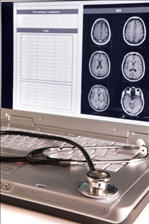Electronic Health Records

We have helped many clients installing and implementing their electronic health records (EHR) software and have gained some insights we would like to share with our readers. We hope this information will be helpful to providers so they can make the best choice for their practice and pocketbook.
The road to choosing the right EHR system is fraught with pitfalls. This article answers frequently asked questions, provides information about how to make the best EHR choice, and tips for a successful implementation.
All certified electronic health record systems are required to have features like e-prescribing, entering allergies, problems, medical history, and medication lists. Where EHR systems differ the most are in the following areas:
Office visit templates vary from simple rapid text, to canned templates with dropdown choices or picklists, and even more advanced templates with decision trees or templates within a template. If your notes are straightforward, you type well, or use speech recognition software, a simple template may work for you.
Integrated dictation is an important feature for some providers, especially surgeons. Family practice physicians don't require this feature as much since they are less likely to have long narratives. Voice recognition software has improved dramatically in recent years which is a great benefit to providers who can get used to using it.
Scanning is an often overlooked feature. The original electronic charting systems were primarily scanning solutions. The medical office is still very paper driven, so scanning should be easy and efficient. Scanning in many systems requires that you scan to your hard drive first and then attach the file in the EHR. What you should look for is a one step scanning solution. Any software demonstration should include how scanning is done.
Document formatting is another important feature that most providers like, but specialists insist upon. The more inexpensive EHR systems have limited capability to customize formatting of the chart note. The most expensive EHR systems do better with this.
Price is a consideration for every practice. Prices on EHR systems range from free to hundreds of thousands of dollars. We work with many solo providers that cannot afford an EHR in the first place so they use a system like Practice Fusion because it is a very low cost solution. It offers a simplistic office template design but it gets the job done.
One of the requirements of an EHR system is a patient portal. This is a secure website that provides for communication between the doctor and patient. Patients can log on and enter their personal health records (PHR) and doctors can send chart records, instructions, lab results, etc. to the patient. It is a useful tool that I find does not get used enough in small practice.
Visitors to this site are most likely providers and medical billers of the individual or small group practice. This is why we recommend low cost EHR solutions. Small practices simply cannot afford expensive systems that large groups use.
What To Look For
Purchase Integrated Systems
Your EHR system must easily interface with your practice management system. Traditional Electronic Health Records systems are usually "cobbled together" and they may not properly interface. Will your EHR vendor handle any problems with the interface or will they tell you to call the practice management software vendor? I can tell you from personal experience; that is the ultimate Catch 22 technical support nightmare.
From the medical billing perspective, we prefer an integrated solution. That is, an electronic health record system combined with medical billing software. Our choice is TotalMD because we like both the medical billing software and the EHR.
It's helpful to get referrals from practices that are already using the EHR system AND your practice management system.
Point of Care Usability
The EHR solution you choose should offer total point-of-care usability. Physicians, nurses, receptions, all other care providers must be able to quickly access and document patient information directly from the point-of-care without inhibiting any aspects of the patient's visit.
Many EHR solutions center on the chart templates and complex macros. They altogether miss the boat on interoffice workflow and intuitive design. Ease of use and flexibility are critical. If it takes too many mouse clicks to handle a task while the patient is in front of you, then duplicate processes are required and any increased efficiency you expected from you EHR will be lost.
Make An Up Front "Apples To Apples" Comparison
It is important to remember that when choosing EHR systems, request a quote of all the associated costs for the practice over a three year period. This includes software and hardware costs, annual software upgrades, maintenance fees, training and support fees.
Some EHR companies make it easy to overlook additional costs during the sales cycle. For example, an initial sales quote is typically a minimum system and the cost may vary widely by number of simultaneous users and numbers of providers and mid-level staff. These companies rely on the fact that once the practice has invested in the initial product, you will be reluctant to switch even if the additional or "hidden" costs are significant.
Implementation Tips
Implement Your System In Stages
Medical offices are very busy places so adding an Electronic Health Records system places a huge burden on the staff. That's why it's a good idea to start off small and build your way up.
Begin by using a limited EHR feature like interoffice messaging. This allows the staff to get the look and feel of the software. Next you can start to scan insurance forms, demographic and HIPAA forms. Follow that with customizing letters to patients and referring providers. This peripheral work is important and requires a lot of setup time.
While the implementation process is moving ahead, the doctor can begin to create note templates. It is very important to have at least some of this in place before going live.
Develop Your Point of Care Workflow
Most doctors find it difficult to transition from paper to electronic. The biggest challenge is entering the note at the point of care in the exam room without inhibiting any aspect of the patient visit. Doctors that are proficient with Tablet PCs or have great typing skills do best. Initially, many providers will enter the note only after the patient has left the exam room. Many providers will make the transition to using the EHR in the exam room. However, for some doctors, this will never happen and that is perfectly acceptable. An Electronic Health Records or EHR system will still be of great value to the practice.
It is helpful to assign one staff member in the office the task of co-ordinating the EHR implementation. This is the "go to person" for all questions and the liason with the software trainer. Also, depending on the practice, it can be helpful to designate a "scribe" to enter chief complaint, present illness and review of systems which helps to lighten the load for the doctor.


